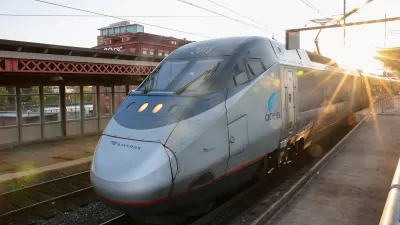Milton Lindsay examines America's efforts to build a national system of high-speed trains and finds mixed results in the nation's eleven intended corridors.
Outside of the existing Northeast Corridor (call it "high-speed" or not) and the just-beginning start-up of California's high-speed rail network, uneven progress has been made on the rest of the nation's designated corridors.
As Lindsay reports, each corridor comes with a completely different set of successes and challenges. For example, on the much-championed California corridor, "California lawmakers approved funding for the first phase of the high-speed rail network. Friday's bill secures the $8 billion needed to begin work on the 130-mile section of track in the Central Valley, which will run from Madera to Bakersfield. Construction on this initial phase of the high-speed rail system is still expected to begin late 2012."
In the Northeast Corridor, "development of an enhanced high-speed rail corridor in the Northeast would cost $151 billion. Amtrak's report also set completion goals for the projects. By 2020, it says it hopes to reduce travel times from Philadelphia to New York to 62 minutes (and to 37 minutes by 2030). Additionally, Amtrak says it will acquire 40 more Acela trains by 2015, which will increase its high-speed service by 40 percent," reports Lindsay.
Still, development has either remained slow or completely stalled in most other corridors. Most projects lack comprehensive funding strategies and timetables for their construction. Of the Florida corridor, including Orlando, Tampa, and Miami, Lindsay states "[t]his project seems like it is pretty much dead." Similarly, political pressure in the South Central corridor have advocates turning to the private sector for funding.
Solutions for advancing high-speed rail include private enterprise, such as in the South Central corridor between Houston and Dallas/Ft. Worth, and using funds for the improvement of existing rail right-of-ways, as in the Chicago Hub Network and Pacific Northwest corridor.
FULL STORY: America and High-Speed Rail: The Progress So Far

Alabama: Trump Terminates Settlements for Black Communities Harmed By Raw Sewage
Trump deemed the landmark civil rights agreement “illegal DEI and environmental justice policy.”

Planetizen Federal Action Tracker
A weekly monitor of how Trump’s orders and actions are impacting planners and planning in America.

How Atlanta Built 7,000 Housing Units in 3 Years
The city’s comprehensive, neighborhood-focused housing strategy focuses on identifying properties and land that can be repurposed for housing and encouraging development in underserved neighborhoods.

In Both Crashes and Crime, Public Transportation is Far Safer than Driving
Contrary to popular assumptions, public transportation has far lower crash and crime rates than automobile travel. For safer communities, improve and encourage transit travel.

Report: Zoning Reforms Should Complement Nashville’s Ambitious Transit Plan
Without reform, restrictive zoning codes will limit the impact of the city’s planned transit expansion and could exclude some of the residents who depend on transit the most.

Judge Orders Release of Frozen IRA, IIJA Funding
The decision is a victory for environmental groups who charged that freezing funds for critical infrastructure and disaster response programs caused “real and irreparable harm” to communities.
Urban Design for Planners 1: Software Tools
This six-course series explores essential urban design concepts using open source software and equips planners with the tools they need to participate fully in the urban design process.
Planning for Universal Design
Learn the tools for implementing Universal Design in planning regulations.
Caltrans
Smith Gee Studio
Institute for Housing and Urban Development Studies (IHS)
City of Grandview
Harvard GSD Executive Education
Toledo-Lucas County Plan Commissions
Salt Lake City
NYU Wagner Graduate School of Public Service




























